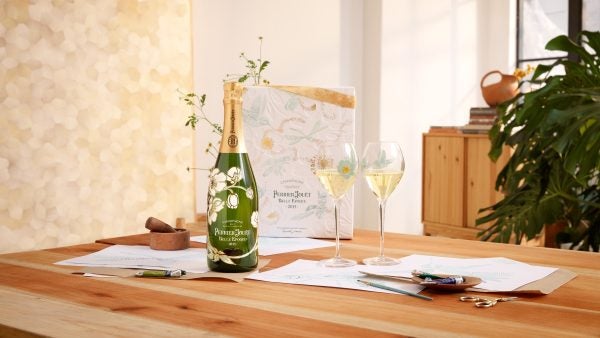Artist and designer Fernando Laposse creates an installation inspired by his observation of nature and the essential connections between different species
Every year since 2012, Maison Perrier-Jouët has commissioned both established and emerging creative talents, with whom it shares a vision of nature, to reinterpret its Art Nouveau heritage for the 21st century. In 2023, the House is delighted to announce its collaboration with the Mexican artist and designer Fernando Laposse, who has created an installation inspired by the flower. He focuses on the key role played by the flower in a series of remarkable relationships within the ecosystem, notably the process of pollination.
Pierre-Nicolas Perrier and Rose-Adélaïde Jouët, who established Maison Perrier-Jouët in 1811, passed on to subsequent generations, not only their vision of champagne, but also their love of art and nature. After their son, Charles Perrier, it fell to Henri and Octave Gallice to keep this heritage alive. The brothers, who were art collectors and aesthetes, met Emile Gallé in 1902.
A noted botanist, he was one of the pioneers of the Art Nouveau movement, which took nature
as a source of inspiration. Emile Gallé decorated a magnum with a Japanese white anemone, evoking the floral style of Perrier-Jouët champagnes. More than a century on, this flower is a fitting symbol of the close relationship with art and nature that has defined Maison Perrier-Jouët since it was founded.
In 2023, Maison Perrier-Jouët is continuing to highlight the need to (re)think our relationship with nature through its new creative partnership with Fernando Laposse. The Mexican artist and designer shares the House’s vision of a world in which all species, mankind included, are of equal importance. From the collaboration between all these life forms, potential solutions may emerge to the environmental problems faced by our societies, holding out the prospect of a brighter future.
Fernando Laposse advocates a return to the observation of nature, as evidenced by his installation, which was inspired by the fundamental role of the flower within the ecosystem to which all species belong. In particular, he focuses on the process of pollination, with its complex and harmonious interactions between plants and the insects and animals which pollinate them. Pollen is the essential connection between the protagonists in this precious, ephemeral event, which is a celebration of life.
Fernando Laposse manifests a profound connection to nature through inspiring projects that raise awareness of ecological challenges, both local and global, including soil erosion and loss of biodiversity. His artistic practice, which is deeply rooted in the rural milieu, has simultaneous cultural, historical, social, political and environmental dimensions. For the past 10 years, Fernando Laposse has been working with native farmers in south-eastern Mexico to develop new materials and systems of production that will benefit the local community and environment. His approach demonstrates that design can be a force for change.
Encouraging meditation, observation and reflection, the installation by Fernando Laposse will be unveiled in an exclusive preview in Tokyo, from 11 to 29 October 2023, in a pop-up space devoted to art, nature and champagne, the three founding pillars of Maison Perrier-Jouët. The House will subsequently exhibit the installation at Design Miami/, in the context of its partnership with the world-leading art fair, from 6 to 10 December 2023.
Ahead of these two rendezvous, Maison Perrier-Jouët has presented two limited editions – for Perrier-Jouët Blanc de Blancs and Perrier-Jouët Belle Epoque 2014 – created by Fernando Laposse and inspired by his installation.
ABOUT FERNANDO LAPOSSE
Fernando Laposse is a London-based Mexican artist and designer, who trained at Central Saint Martins as a product designer. He specialises in transforming humble natural materials into refined design pieces, working extensively with overlooked plant fibres such as sisal, loofah and corn leaves. He often works with indigenous communities in his native Mexico to create local employment opportunities and raise awareness about the challenges they face in a globalised world. His projects are informative and educational, addressing topics such as the environmental crisis, loss of biodiversity, community dissolution, migration and the negative impacts of global trade in local agriculture and food culture. His work documents the issues and announces possible resolutions through the transformative power of design. His projects have been exhibited at the Triennale di Milano, the Cooper Hewitt Design Museum, the Victoria & AlbertMuseum, the World Economic Forum and Miami Basel, among others.
ABOUT MAISON PERRIER-JOUËT
Maison Perrier-Jouët was founded in 1811 by a couple united by their love of nature and passion for art. From the start, they chose the Chardonnay grape variety as the signature of the House, defining the floral style which sets Perrier-Jouët champagnes apart. For more than two centuries, Maison Perrier-Jouët has evolved in close relationship with nature, guided by the free spirit of its founders and the exuberance of the Art Nouveau movement. Nature remains its primary source of inspiration. The Earth is a common garden, which the House cultivates as it crafts its champagnes. Fired by creative freedom, Maison
Perrier-Jouët nurtures a joyful, positive vision of the world.







